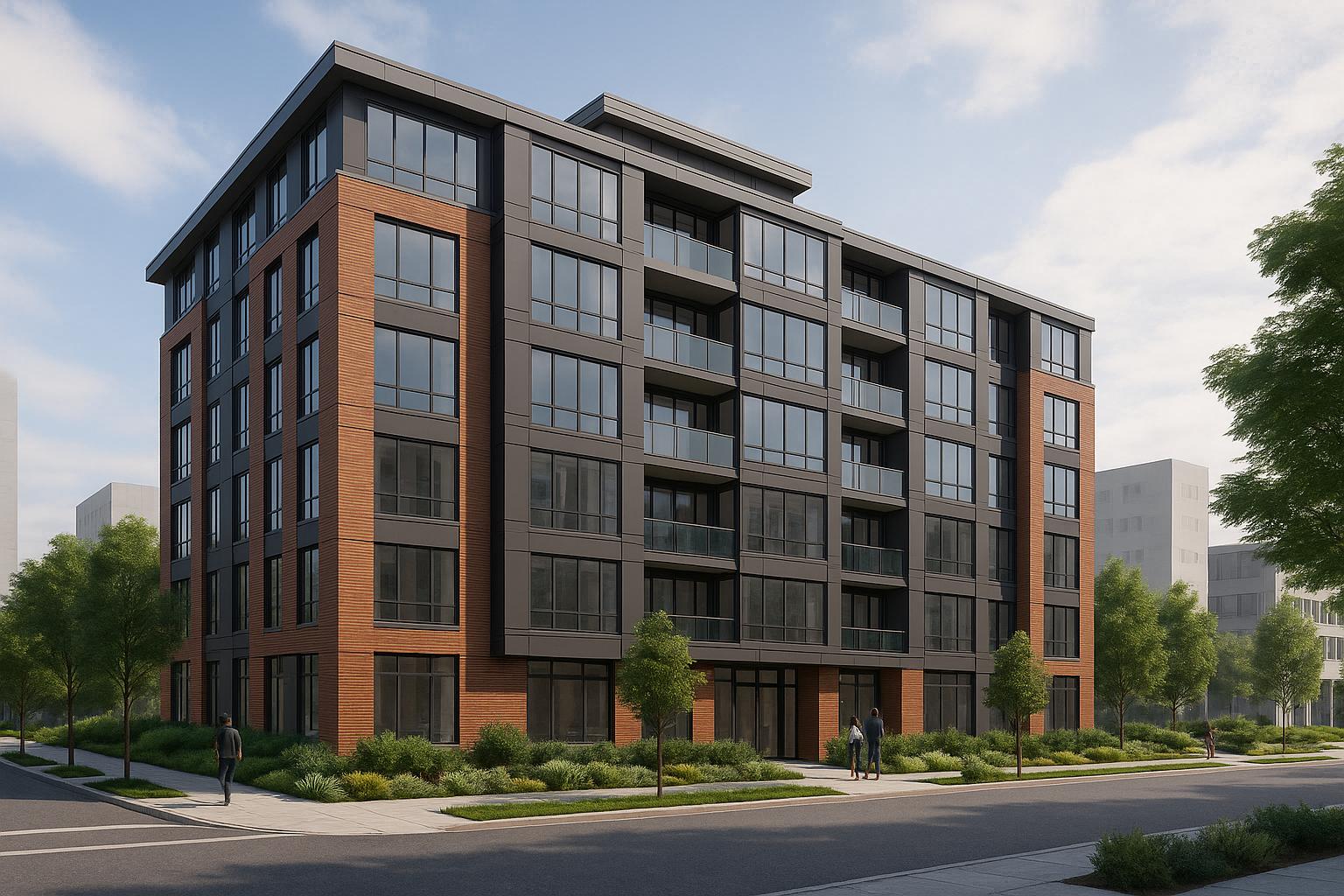The COR SPA package is a mandatory set of documents for property owners in Nova Scotia planning to build or renovate multi-unit rental properties. It ensures compliance with local regulations, zoning laws, and safety standards. Here's what you need to know:
- Purpose: Approves construction plans for multi-unit properties (4–24 units) near Halifax, ensuring they meet municipal and provincial standards.
- Key Documents: Site plans, architectural drawings, engineering reports, zoning compliance, environmental assessments, and infrastructure connection plans.
- Common Issues: Missing documents, outdated plans, conflicting details between contractors, and unclear language can delay approvals.
- Submission Standards: Metric measurements, consistent scales, professional stamps, and Canadian formatting are required.
- Fees and Timing: Municipal fees range from $2,500 to $8,000. Complete submissions take 4–6 weeks; incomplete ones are returned immediately.
For faster approval, use an integrated team to ensure consistent documentation, schedule pre-submission meetings, and conduct quality checks before submitting.
Required Documents and Submission Standards
Getting your submission right the first time is crucial. Missing or improperly formatted documents can push back approval by weeks - or even months. Here's what you need to know to avoid delays.
Complete Documentation List
To meet compliance for your COR SPA submission, ensure you include the following key documents:
- Core technical drawings: These should detail your project layout. Site plans must show property boundaries, existing and proposed structures, setbacks, parking areas, and landscaping. Everything must be to scale with exact measurements.
- Architectural drawings: Provide floor plans for all levels, elevations from all sides, and cross-sections showing interior heights. Include detailed views of special features like balconies or rooftop access. Don’t forget room dimensions, ceiling heights, and schedules for windows and doors.
- Engineering reports: These cover the technical systems of your building. Structural reports should address foundation design, load-bearing elements, and seismic safety. Mechanical and electrical reports need to include HVAC systems, plumbing, electrical capacity, and emergency systems like fire alarms and sprinklers.
- Zoning compliance documents: Prove your project aligns with local regulations. This includes a zoning compliance letter, parking and density calculations, and evidence of adherence to height restrictions, lot coverage limits, and any overlay zones.
- Environmental assessments: Show how your project impacts the surrounding area. Include stormwater management plans with runoff calculations and, if necessary, environmental impact studies for properties near wetlands or sensitive areas.
- Infrastructure connection plans: Detail how your building will connect to municipal services like water, sewer, and electricity. For larger projects, traffic impact studies may also be required.
Technical Format Requirements
Municipal reviewers expect a high level of precision. Here are the key technical standards:
- Metric measurements: Use metres for property dimensions, building heights, and setbacks. Room areas should be in square metres, lot sizes in hectares, and temperatures in Celsius. All calculations must comply with Canadian building codes.
- Drawing scales: Ensure scales are consistent and clearly marked. Use 1:200 or 1:500 for site plans and 1:50 or 1:100 for detailed architectural drawings. Text must be legible - minimum 2.5mm for regular text and 3.5mm for titles.
- Professional stamps and signatures: All drawings and reports must be stamped and signed by licensed professionals registered in Nova Scotia. Include the registration number and signing date on each document.
- Language and formatting: Use Canadian spelling (e.g., "colour", "metre") and the DD/MM/YYYY date format. Currency amounts should follow Canadian conventions, such as $125,000.00.
These standards ensure your submission meets local expectations and avoids unnecessary delays.
Nova Scotia Submission Rules
When submitting your documents, follow these specific guidelines:
- File formats: Submit drawings as PDFs (maximum 10MB per file) and CAD files in AutoCAD DWG 2018 or newer. Photos and site images must be JPEGs with at least 300 DPI resolution.
- Paper copies: Requirements vary, but most municipalities ask for three sets of all drawings and reports. Use standard 8.5" × 11" or 11" × 17" paper, folding larger drawings to fit. Binding should allow the documents to lay flat - spiral binding or saddle stitching works best.
- Submission timing: Timing is critical. Municipalities usually process applications in the order they’re received. Complete submissions typically take 4-6 weeks for an initial review, while incomplete ones are returned immediately, causing delays. For example, Halifax Regional Municipality requires all supporting documents to be submitted within 30 days of the initial application; otherwise, the file is closed.
- Fees: Municipal fees range from $2,500 to $8,000, depending on the project’s size and complexity. Resubmissions after rejection usually cost 50% of the original fee. Some municipalities offer expedited reviews for an extra 25% fee, reducing the review time to 2-3 weeks.
- Review coordination: Multiple municipal departments - like planning, engineering, fire services, and environmental agencies - often need to approve different parts of your project. A missing signature or document can cause significant delays, so coordinating your submission is key to keeping things on track.
What Reviewers Check During COR SPA Review
When you submit your package for review, it undergoes a thorough evaluation to ensure it meets building code and safety standards. Reviewers go through your documentation, test data from accredited labs, and installation instructions to confirm compliance.
If your building products or systems fall outside the scope of standard codes, additional assessments may be required. These special evaluations focus on construction methods, test results, and installation details, ensuring that unconventional or intricate components still meet the necessary requirements. Once everything checks out, an evaluation report is issued.
To avoid delays, it's crucial to provide complete and accurate technical documentation. Post-approval inspections and quality checks are conducted to confirm ongoing compliance, making these initial reviews a key step in maintaining high standards throughout the process.
How to Avoid COR SPA Submission Problems
Many COR SPA rejections stem from avoidable mistakes during the preparation phase. By understanding common errors, you can ensure your submission package is complete and ready for approval on the first try.
Common Documentation Mistakes
One of the most frequent issues is missing signatures and dates. Every required document must be signed and dated by the appropriate parties as soon as it's finalized. Missing or incorrect signatures can cast doubt on the validity of your documents and lead to delays in the process [1].
Another common error is submitting outdated plans and specifications. This often happens when multiple consultants work with different versions of project documents. To avoid this, make sure all drawings, engineering reports, and technical specifications reflect the same project version and completion date. Reviewers are quick to catch inconsistencies between documents with conflicting dates.
Incomplete checklists are another red flag. Nova Scotia's COR SPA requirements outline specific standards for content, format, and submission timing [1]. Property owners should carefully verify that every required item is included before sending the package for review.
Finally, unclear language can slow everything down. Submissions should avoid jargon, ambiguous terms, or obscure abbreviations. Instead, use straightforward, easy-to-understand language. If reviewers can't make sense of your documentation, they'll request clarification, delaying approval [1].
Beyond documentation errors, poor coordination among contractors can further complicate submissions.
Problems with Multiple Contractors
When different companies handle planning, architecture, engineering, and construction, their lack of coordination can create serious issues.
Mismatched specifications and poor communication are common problems. For instance, a structural engineer might assume the architect has included certain details, while the architect expects the engineer to handle them. This miscommunication can result in missing information that delays the review process.
Misaligned schedules add to the confusion. Your architect might complete drawings in April, but your engineer might not finish calculations until August. By then, building codes or municipal requirements could have changed, forcing you to update earlier work.
Accountability issues also arise when errors occur. With multiple contractors in the mix, figuring out who's responsible for fixing a problem can take time, further delaying your resubmission.
Single Team vs. Multiple Contractors Comparison
| Aspect | Single Integrated Team | Multiple Contractors |
|---|---|---|
| Documentation Consistency | All documents created together with matching specifications | High risk of conflicting information between consultants |
| Communication | Internal coordination within one company | External coordination across several separate companies |
| Accountability | One point of contact for all issues | Multiple contacts, unclear responsibility for problems |
| Timeline Control | Coordinated schedule for all submission components | Independent schedules that may not align |
| Quality Assurance | Single quality control process across all documents | Separate processes that may overlook integration issues |
| Cost of Errors | Internal fixes at no extra cost | Additional fees from multiple consultants for revisions |
| Submission Speed | Faster preparation with integrated workflow | Slower coordination between separate parties |
This comparison shows how a single integrated team can simplify the process. By working with a design-build team, you ensure that all documentation is consistent and coordinated internally, avoiding the delays and complications that often come with managing multiple contractors.
sbb-itb-16b8a48
How to Get COR SPA Approval Faster
Delays in the approval process can disrupt rental income and project timelines. A thorough quality review and a streamlined construction approach can significantly speed things up.
Quality Checks Before Submission
Submitting a complete and error-free package is crucial. Start by having a third-party technical review of your structural calculations and drawings. An independent professional engineer can help identify technical issues that might otherwise lead to additional questions from reviewers.
It’s also a good idea to schedule pre-submission meetings with municipal staff. Many municipalities in Nova Scotia offer informal consultations before the formal submission process. These meetings can clarify requirements and flag potential issues early on.
Ensure that every technical component has professional sign-off. Use strict document version control, with consistent revision dates, to maintain accountability. This approach not only demonstrates professionalism but also sets a solid foundation for contractual clarity.
Why Fixed-Price Single Contracts Work Better
Municipal reviewers value submissions that demonstrate clear accountability and financial stability. Fixed-price contracts offer predictable costs, making budgeting and financial planning straightforward [2][3][4]. These contracts require a well-defined scope from the start, detailing deliverables, timelines, and milestones. This level of clarity reassures reviewers that your project is financially sound and shifts the risk of cost overruns to the contractor.
Moreover, having a single accountable party simplifies the review process. Instead of reconciling details from multiple contractors, reviewers can focus on a single, cohesive submission. This streamlined approach often leads to faster approvals.
How Helio Urban Development Streamlines COR SPA

Helio Urban Development has developed an integrated design-build process that addresses common coordination challenges in COR SPA approvals. As Nova Scotia’s only design-build company specializing in 4+ unit rental properties, Helio combines the expertise of planners, architects, engineers, and construction teams into a unified workflow. This integration ensures that submission documents are consistent and reduces the risk of conflicting information, which can delay municipal reviews.
Helio’s process is backed by a 6-month construction guarantee, with financial penalties of up to $1,000 per day for delays. Property owners also benefit from daily project updates and real-time access to progress through a dedicated portal featuring photo updates.
Co-founders Lloyd Liu and Yuan He emphasize realistic budgets and optimized schedules through meticulous oversight. Their fixed-price construction model is set at $160,000 per unit and includes triple quality verification. This involves five Professional Engineer inspections during construction and a 2-year warranty on all work. Thanks to this rigorous approach, Helio has achieved zero cost overruns and seamless project execution across 31 units built for clients.
COR SPA Success: What Property Owners Need to Remember
Getting approval for your development project in Nova Scotia isn't about presenting lofty ideas or good intentions - it's about delivering precise, complete, and regulation-compliant documentation. Municipal reviewers focus on whether your project meets the province's strict standards, not on its potential.
Every single document matters. From structural calculations to environmental assessments, everything must be professionally prepared, correctly dated, and perfectly aligned with municipal bylaws, provincial codes, and environmental rules. Keeping track of document versions is critical - mistakes or inconsistencies can lead to delays or rejections.
Disorganised coordination among contractors, architects, and engineers is another common stumbling block. When submissions from different parties don't align, reviewers are left to untangle conflicting details, which not only drags out the process but often results in additional requests for clarification.
One way to avoid these issues is to adopt an integrated construction approach. By having your design and construction teams work together from the start, you ensure that all submission documents are consistent. This approach reduces the risk of conflicting information that can slow down municipal reviews. Fixed-price contracts can also help by showing financial stability and confirming that your project is backed by a solid budget.
Timely approvals often come down to systematic planning and delivery. Pre-review quality checks can catch errors early, leading to faster approvals and fewer revisions.
Ultimately, having a single, integrated team manage the entire process - from planning to construction - makes a world of difference. It streamlines coordination, ensures a cohesive submission, and demonstrates clear oversight, which can significantly speed up the approval process.
FAQs
What are the most common mistakes property owners make when submitting a COR SPA package, and how can they prevent them?
The most common errors property owners face when submitting a COR SPA (Construction Operations Review - Site Plan Approval) package in Nova Scotia are tied to missing documents, incorrect information, and non-compliance with technical standards. These mistakes can lead to delays or even outright rejections, both of which can be costly and highly frustrating.
To steer clear of these setbacks, make sure every required document - such as drawings, studies, and compliance materials - is meticulously prepared and thoroughly reviewed before submission. It’s also wise to work with professionals like planners, engineers, or legal experts who are well-versed in Nova Scotia’s site plan approval process. Their expertise can help catch potential issues early, making the entire process smoother and more efficient.
What are the advantages of using a single, integrated team for COR SPA submissions instead of managing multiple contractors?
Using a single, unified team for your COR SPA submission can make the entire process much smoother and more efficient. It ensures clear communication and consistent oversight of all documentation and compliance tasks, significantly lowering the risk of mistakes, delays, or even rejections. When one team manages everything, property owners can sidestep the common challenges of juggling multiple contractors with differing priorities.
This setup also means better accountability - one team takes full ownership of meeting technical standards and ensuring the approval process runs seamlessly. By eliminating disjointed workflows, property owners can save time, reduce stress, and keep their project on track without unnecessary complications.
How can I speed up the COR SPA approval process and avoid delays?
To accelerate the COR SPA approval process in Nova Scotia and sidestep unnecessary delays, make sure your submission package is thorough, precise, and meets all requirements. This means including everything from detailed site plans and technical drawings to any required studies specified in the ER-3 SPA guidelines.
It's also a good idea to connect with relevant authorities, like the Nova Scotia Department of Environment, early on. This allows you to tackle potential concerns right from the start. Taking the time to plan carefully, communicate proactively, and double-check the requirements can make the approval process much smoother and help avoid setbacks.
By staying organized and addressing any issues upfront, you'll save time and create a clearer path to approval for your multi-unit rental project.



